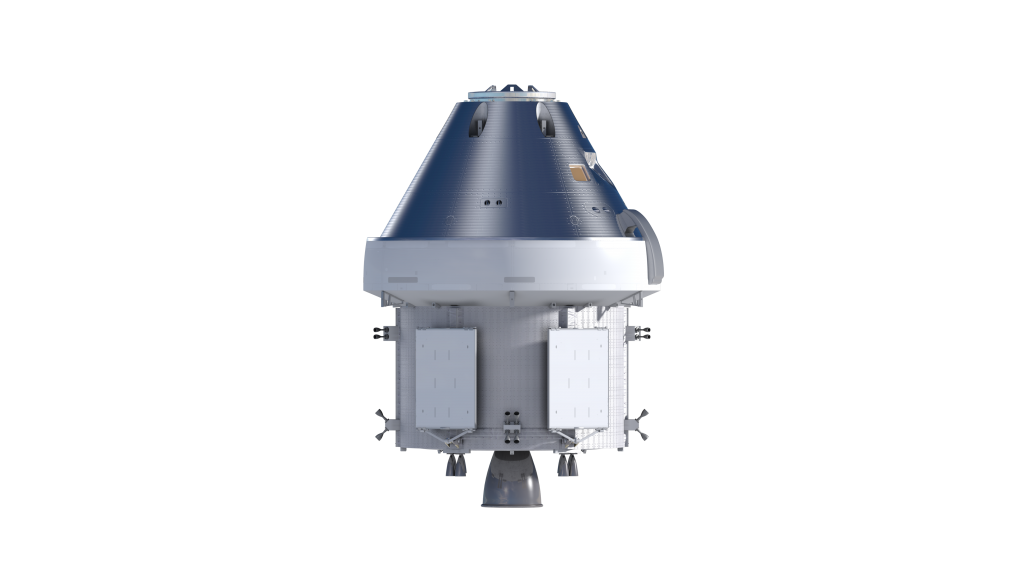On its sixth day into the Artemis I mission, Orion and the European Service Module completed their fourth orbital trajectory correction burn using the auxiliary engines at 08:44 CET (07:44 GMT) ahead the first of two manoeuvres to enter a distant retrograde orbit around the Moon.
The first three trajectory correction burns provided an opportunity to fire all three thruster types on Orion, the first firing (on flight day one) used the large orbital manoeuvring system engine OMS-E, the second (on flight day two) used the European reaction control system thrusters, and the third (on flight day five) used the medium-sized auxiliary engines.


A key moment for the mission Orion’s outbound powered flyby that occurred at 13:44 CET (12:44 GMT) on 22 November, passing just under 130 km above the surface at 13:57 CET (12:57 GMT). The spacecraft’s speed increased from 3424 km/h before the burn to 8211 km/h after the burn. Shortly after the outbound flyby, Orion passed about 2250 km above the Apollo 11 landing site at Tranquility Base at 14:37 CET (13:37 GMT).
During a 34-minute period Orion and the European Service Module flew behind the Moon and communications was lost, as expected. Orion re-acquired signal with NASA’s Deep Space Network at 13:59 CET (12:59 GMT). The European Service Module had initiated the orbital powered flyby on cue, firing the large main engine for 149.5 seconds to accelerate the spacecraft at a rate of more than 933 km/h. It used 800 kg of MON oxidiser and 500 kg of MMH fuel to execute the burn.
“The mission continues to proceed as we had planned, and the ground systems, our operations teams, and the Orion spacecraft continue to exceed expectations, and we continue to learn along the way about this new, deep-space spacecraft,” said Mike Sarafin, NASA’s Artemis I mission manager.
Far from the Moon
Orion will enter a so-called distant retrograde orbit beyond the Moon on 25 November with the second orbital manoeuvre, called the distant retrograde orbit insertion burn. The orbit is “distant” in the sense that it’s at a high altitude from the surface of the Moon, and it’s “retrograde” because Orion will travel around the Moon opposite the direction the Moon travels around Earth. This orbit provides a highly stable orbit where little fuel is required to stay for an extended trip in deep space to put Orion’s systems to the test in an extreme environment far from Earth.

Orion will travel about 92194 km at its farthest point from the Moon on 25 November, passing the record set by Apollo 13 for the farthest distance travelled by a spacecraft designed for humans, as on 26 November Orion and the European Service Module will be over 400 000 km from Earth and reach its maximum distance from Earth of 432192 km on 28 November.
Fuel report
On 21 November the European Service Module had used 1685 kg of propellant 34 kg less than expected values. There is now a 958 kg propellant margin for Artemis I, an increase of 91 kg more than calculated before launch.
Just after 19:45 CET (18:45 GMT) on 21 November, Orion has travelled 348973 km from Earth and was 21636 km from the Moon, cruising at 5615 miles per hour.


 Automated Transfer Vehicle page
Automated Transfer Vehicle page ATV blog archive
ATV blog archive
 NASA Orion page
NASA Orion page NASA Artemis
NASA Artemis Airbus Orion page
Airbus Orion page
Discussion: 4 comments
I am wondering why there was so little camera footage from the close flyby, I assume that all onboard camera’s were recording during the radio silence and that this data was retreived after the flyby. This is really a missed opportunity for NASA and ESA to generate more media coverage….
Unlike the International Space Station, Orion is not flying in low-Earth orbit, communications with Orion pass through the Deep Space Network and the data rate for deep space os far smaller than for the International Space Station that is flying just 400 km above. Orion will fly as far as 400 000 km from Earth, 1000 times farther. Downloading a picture takes a lot of time, far more than in low-Earth orbit, and even more time for a video.
Downloading of images does not have priority over the downloading of critical flight information. Some moments are recorded and stored in hardware storage space in the Crew Module memory, that we will have access to on landinge, but even here space is limited.
Schöne Aufarbeitung! Aber stimmen die Geschwindigkeiten? Bei der NASA steht folgendes: At the time of the burn, Orion was 328 miles above the Moon, travelling at 5,023 mph. Shortly after the burn, Orion passed 81 miles above the Moon, travelling at 5,102 mph. At the time of the lunar flyby, Orion was more than 230,000 miles from Earth.
Außerdem hält nicht Apollo 14, sondern Apollo 13 den Rekord.
Viele Grüße
Tony (Mondgeflüster)
Hi, thanks for the comments. “Apollo 14” should have been Apollo 13, corrected. The distances to the Moon are correct though, we don’t mention the altitude of outbound powered flyby initiation, and mention just the lowest point to the Moon.